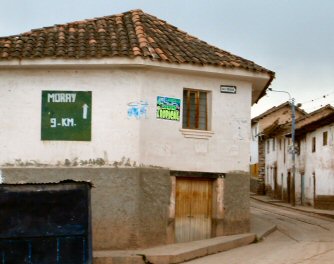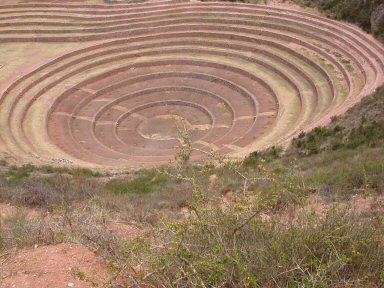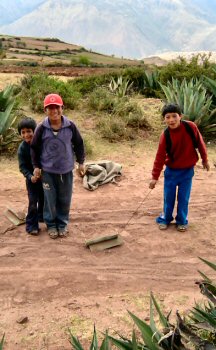The Road to Moray: Our Peru Adventure Vacation
Note: This Peru adventure vacation page is part of a series of blogs that we did while learning Spanish language in Peru. Each blog focuses on one or two language learning strategies. They are designed so show you how to implement Walkabout language learning strategies. Use our examples here for any language you want to learn. See the "More Peru Stories" list of links on this page for additional language learning strategies. Also see our Learn Spanish section.
 Sign points the way to Moray, Peru.
Sign points the way to Moray, Peru.Ann Marshall
We were off on our own Peru adventure vacation, an ad hoc group of 10: teachers and students from Maximo Nivel, organized by Luz, our Spanish teacher, headed for the historic and mystical circles of Moray. In addition to seeing the sites, we'll use this trip for learning Spanish language.
We gathered around an aging public bus with Peruvian farmers, housewives, working kids with heavy bundles, and a cadre of extreme bikers – foreigners clad in your basic body armor hoisting their bikes on top of the bus. We squeezed sideways down the aisle, and slid angle wise into our reserved seats. Cost: US$1 each. With the seats filled, we quickly gained a new appreciation of the "capacious" space we get in today's airplanes.
Now for the Standing-Room-Only Folks
Then came the standing-room-only passengers. They stuffed themselves into the aisle, including a 9-year-old kid jammed against the armrest of my seat, his head wedged among the bodies just 6 inches from mine. He and the diminutive woman next to him steadied themselves by reaching across the back of the seat in front of me, anchoring the three of us together for the hour-long ride. (This redefinition of my personal space was the first leg on my Peru adventure vacation.) The bus lurched up the hillside toward the Sacred Valley around Cusco.
More Peru Stories
Intensive Spanish
The child remained impassive when the bus pitched from side to side and the distance between our faces closed to 2 inches. He became a bit more exercised only when he had to yank his bulging woven bag between the legs of tightly packed passengers so he could get off in the 30 seconds he had when it paused on a wind-swept knoll at a lonely bus stop – four slender tree posts topped by a rusting corrugated tin roof, no walls, no seat. The sprawling farmland was unbroken by buildings for miles around. Clearly, he had a long walk ahead.
We debarked at another isolated stop and hired taxis waiting to take us to the pueblo of Maras. Cost: 33 cents per person. This tiny pueblo's plaza was unencumbered by people or cars. Saturday morning in the pueblo was a world apart from Cusco. Progress, and the main road had bypassed Maras.
On the next leg of our Peru adventure vacation, we headed toward a sign (see photo above) that said "Moray, 9 km" (5.12 miles), and trekked up a narrow concrete and cobblestone street decorated with aging colonial gingerbread on the window frames. Once out of town we picked our way through an obstacle course of donkey droppings and hiked into the hilly ochre farmland that stretched for miles to embrace the majestic snow-capped Andes.
On the Trail to Mystical Moray
The day was gorgeous: high clouds broken by the occasional patch of blue sky afforded some protection from the sun. Over each new rolling hill, colorfully clad Inca men and women worked the fertile fields, while children and dogs tended sheep and cows. As we passed, Luz gave each child a handful of candies to share with siblings. The distance to the sacred circles of Moray melted away.
 Circles at Moray, Peru. Were they Incan research stations?
Circles at Moray, Peru. Were they Incan research stations?Ann Marshall
Atop the first hill at Moray, the land dropped away in concentric circular terraces demarked by stone walls (see photo). Some speculate this was an ancient agricultural research station where the Incas experimented to improve their crops, with each level offering a different temperature and relative humidity. We descended down rough stone stairs jutting out of the walls to form staircases.
On the third leg of our Peru adventure vacation, in the center at the bottom of the circular terraces, Luz instructed us how to benefit from the sacred energy of Moray. We each formed a fan of three coca leaves, made silent wishes for our hearts' greatest desires, blew on the leaves three times, then made a small offering of the leaves, which we buried before we lay on our backs on the ground to absorb the natural energy.
 Luz showed us a ritual to absorb the sacred engergy of Moray.
Luz showed us a ritual to absorb the sacred engergy of Moray.Terry Marshall
The sun had burned the high clouds away, and now it beat down on us. I waited for the energy. My feet began to pulse as if I were standing on large wooden rollers of different sizes and shapes . . . Maybe I was trying too hard to capture the energy.
While the others broiled themselves under the blazing sun, I watched two guys in our group playing catch with a tennis ball they had brought. Throughout our hike, I marveled at their skill. They threw it great distances, ran, and, barely glancing over their shoulders, caught it with a single hand, casually commanding expertise I could only wish for.
A Mini-Miracle?
On the fourth leg of my Peru adventure vacation, as I labored up the giant steps on a stone staircase, one of the guys, still at the bottom, snatched up an old stick of wood to whack the tennis ball to his buddy, now at the top of the terraced circles. It went badly off-target. Teetering in my precarious position on one of the stone stairs, I watched the tiny speck of a ball hang high in the air, then plummet toward me. I did what I do best: I made motions to catch it . . . and closed my eyes.
My eyes popped open. Wonder of wonders, I had caught it. Me, the kid who was always chosen last for ball teams in grade school, the one who never caught a ball in her life. Was it the special energy of the place? Or just a fluke? Doesn't matter: I am vainly proud of myself. I didn't even fall off the steps. That may not be mystical, but for me it was pure magic.
Our Peru Adventure Vacation
On the fifth leg of Peru adventure vacation, as we made our way back after lunch, we practiced learning Spanish language using the two forms of Spanish past tense we had covered the previous week with Luz by telling crazy stories about close calls with fire from our childhood, Cuando yo era niña . . . (When I was a child . . .) This story-telling was a new twist on Walkabout Language Learning that we found useful on other occasions when we were with Peruvian friends. You can use it anytime, anywhere, tell outrageous stories or serious. It becomes a cross-cultural sharing as well as a language lesson.
 Boys play with trucks crafted from yucca plants, Moray, Peru
Boys play with trucks crafted from yucca plants, Moray, PeruAnn Marshall
We also chatted with some machete-wielding boys who had hacked off chunks of yucca plants and crafted them into dump trucks. (See photo at right – and take a look at the farmland and mountain looming in the distance while you are at it.) I wondered where they might have even seen such a truck on this isolated mountainside.
We passed white-legged tourists on their own Peru adventure vacation – jouncing across the rough terrain toward Moray on bicycles. The pain on one girl’s face seemed to shout, "And for this I paid $200?"
I grinned. Our own Peru adventure vacation, which cost us a total of $8 for transportation plus $10 for groceries and snacks for the three of us, had to have been at least as much fun as hers.
When we arrived back at the Maras plaza, we debated about pursuing the next leg of our Peru adventure vacation: a hike to the Maras salineras (salt mines). Our Peruvian friends had told us the mines were worth the trip. The additional five miles or so, plus rain convinced us to save it for another day. I was relieved the young guys pushed to postpone the salt mine trip; I didn't have to admit my own exhaustion.
We saw no sign of motorized transportation at all, let alone taxis for hire to take us back to the highway. After huddling under shelter from the rain for half an hour, we descended on a single taxi that drove into sight and stuffed ourselves – all 10 of us – inside. Luckily, from my position sitting on Terry's lap – with my head bent over and shoulders touching the roof – I couldn’t watch the taxi hurtle down the hillside. Ten long minutes later, we creaked to a stop and tumbled out on the ground like circus clowns. We were back at that isolated bus stop where we had bailed out of the bus in the morning.
This time we weren't alone. A wizened Inca woman hunkered by the highway, waiting for the bus back to Cusco. She held out her hand. I shook it. She held it out again. I realized she wanted some water. I handed her my bottle. She drank deeply and tried to return it. I offered the bottle to her husband. He shook my hand, took the bottle, then drank. I told them it was theirs. It was the right thing to do. Besides, there's the germ thing ... I don't usually even share water bottles with my kids.
If you want to learn how to turn your sight seeing trips in to personalized language learning lessons, download the Walkabout Language Learning Action Guide. It shows you step by step how to make your own language learning program and track your progress.
Learning Spanish Language
- The best cultural adventures may cost next to nothing.
- Use story-telling as one of your language learning strategies. You can practice your language anywhere two people with different mother tongues gather.
- No matter where you go, boys love trucks.
- When on a Peru adventure vacation in Moray, be open to magical experiences ...
--Posted by Ann, October 27
← Previous: Mario Vargas Llosa Next: Ultimate Fighting Championship →
Return from Peru Adventure Vacation to Language Lore
Return to Your Language Guide home
Stay in Touch with Language Lore ezine
Want to stay in touch? Subscribe to Language Lore, our internet language learning email newsletter. This free ezine facilitates your language learning journey. See our back issues here.
Go to your email now to confirmation your subscription. If you don't see an email within an hour (check your junk mail folder too), please contact us. We respect your privacy and never sell or rent our subscriber lists. If you want to get off this list later, one click unsubscribes you.

New! Comments
Have your say about what you just read! Leave me a comment in the box below.